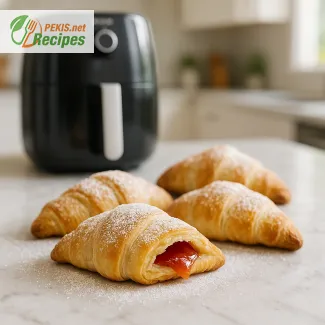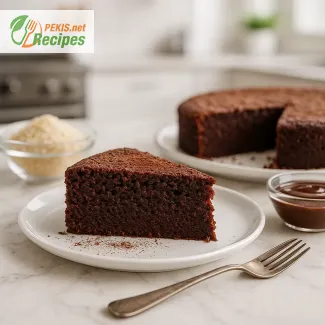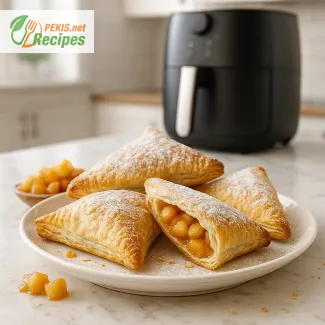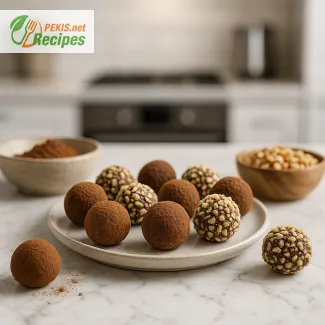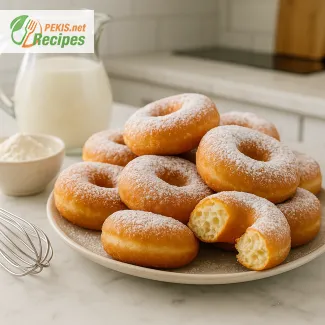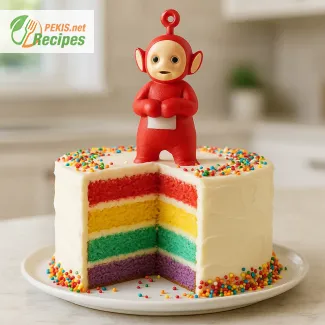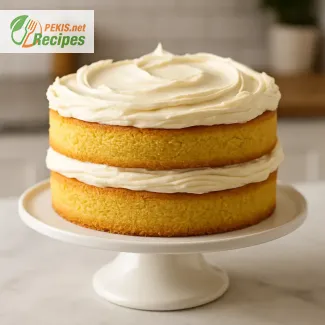
A heavenly vanilla creation with rich buttercream layers
Discover the timeless elegance of a classic vanilla butter cake
There is something eternally comforting and indulgent about a vanilla butter cake with buttercream frosting—a dessert that exudes both sophistication and nostalgia. This cake isn’t just a treat; it’s a celebration of everything that makes homemade baking truly special. With its light and airy crumb, buttery richness, and smooth, creamy frosting, this cake strikes the perfect balance between flavor and texture. Whether you're planning a birthday, wedding, or a cozy afternoon tea, this vanilla butter cake brings elegance to any table.
The heart of this cake lies in the quality of ingredients and the precision of the method. From the golden-hued butter that infuses each layer with richness, to the pure vanilla extract that offers warmth and depth, every bite tells a story of tradition and care. The buttercream frosting, soft and luscious, adds a velvety finish that complements the moist cake perfectly. It's not overly sweet, but just right—enhancing the cake rather than overpowering it.
The charm of a homemade vanilla butter cake is its simplicity. Unlike heavily decorated cakes or complex patisserie, this dessert relies on fundamental techniques and essential ingredients to deliver its wow factor. The cake is tender but sturdy enough to hold its shape, making it ideal for layered presentations. Meanwhile, the buttercream frosting spreads effortlessly and holds beautifully, whether you're aiming for rustic swirls or smooth, polished finishes.
One of the most appealing aspects of this recipe is its versatility. The base cake can be used in single-layer, double-layer, or cupcake forms, and the buttercream can be easily adapted with additional flavors like lemon zest, almond extract, or even a touch of liqueur for a more grown-up twist. This adaptability makes it a favorite among home bakers and professional pastry chefs alike.
While there are countless cake recipes out there, few deliver the consistent, melt-in-your-mouth texture of this vanilla butter cake. The key lies in the precise balance of moisture, structure, and flavor. Softened butter is creamed to perfection with sugar until it’s light and fluffy, then gently folded with eggs and flour to preserve the airiness. A dash of whole milk or buttermilk provides moisture and a tender crumb, ensuring that every bite is soft and satisfying.
When it comes to the frosting, European-style butter often adds extra richness and a silkier texture. Combined with powdered sugar and just a splash of cream or milk, the butter transforms into a smooth, spreadable icing that clings lovingly to every surface of the cake. A touch of salt can be added to bring out the natural sweetness and make the vanilla notes truly shine.
This classic vanilla butter cake with buttercream frosting is a staple in many households because it’s both beautiful and approachable. It has the kind of nostalgic charm that makes it a regular feature at family gatherings, yet it’s elegant enough to serve at weddings or upscale celebrations. Its neutral flavor profile allows it to pair well with a wide range of beverages, from a steaming mug of coffee to a chilled glass of champagne.
In the world of cakes, the vanilla butter cake holds a special place for its delicate crumb and rich, buttery flavor. The buttercream frosting provides a luxurious finish that elevates the cake without overwhelming it. This balance is what makes it a timeless choice—loved by children and adults alike. Whether you’re baking for a celebration or simply to satisfy a sweet craving, this cake delivers on every level: flavor, texture, appearance, and satisfaction.
The visual appeal is just as compelling as the flavor. With a golden crust and a pale, buttery interior, the cake is a feast for the eyes before it even touches the palate. The buttercream, whipped to perfection, offers just enough gloss and body to make decorating an enjoyable experience, not a chore. Swirled, piped, or smoothly finished, it allows creative freedom for presentation while maintaining its role as a perfect textural contrast to the tender cake layers.
This is more than just a cake—it’s a celebration of butter and vanilla, a showcase of how simple ingredients, when treated with care and respect, can produce extraordinary results. Perfect for birthdays, anniversaries, or an indulgent weekend bake, the vanilla butter cake with buttercream frosting is a go-to recipe that never goes out of style. Its popularity across generations and cultures stands as a testament to its irresistible charm and universal appeal.
1. Preparing the vanilla butter cake
- Preheat your oven to 175 °C (350 °F). Grease and flour two 20 cm (8-inch) round cake pans or line with parchment paper.
- In a large mixing bowl, cream together the unsalted butter and granulated sugar using a hand or stand mixer until the mixture is pale and fluffy (about 3–4 minutes).
- Add the eggs, one at a time, beating well after each addition to ensure complete incorporation.
- Mix in the vanilla extract.
- In a separate bowl, sift together the all-purpose flour, baking powder, and salt.
- Gradually add the dry mixture to the wet ingredients, alternating with the milk, beginning and ending with flour. Mix just until combined; do not overmix.
- Divide the batter evenly between the prepared cake pans and smooth the tops with a spatula.
- Bake in the preheated oven for 30–35 minutes, or until a toothpick inserted in the center comes out clean.
- Allow the cakes to cool in the pans for 10 minutes, then turn out onto a wire rack to cool completely before frosting.
2. Preparing the buttercream frosting
- In a large bowl, beat the unsalted butter until smooth and creamy (about 2 minutes).
- Gradually add the powdered sugar, beating well between additions.
- Add the vanilla extract, milk (or cream), and salt. Continue to beat for 3–5 minutes until the frosting is light, fluffy, and spreadable. Add more milk if needed to reach the desired consistency.
3. Assembling the cake
- Level the cake layers if necessary using a serrated knife.
- Place one layer on a serving plate or cake stand. Spread an even layer of buttercream frosting on top.
- Add the second cake layer and frost the top and sides of the cake with the remaining buttercream.
- Decorate as desired. The cake can be served immediately or chilled for a firmer texture.
Creative ways to elevate a classic vanilla butter cake
Explore ingredient upgrades, common mistakes, and healthier variations
When it comes to timeless desserts, few can rival the charm of a vanilla butter cake with buttercream frosting. However, even a classic can be transformed with subtle tweaks that enhance flavor, improve texture, or cater to modern dietary preferences. Whether you’re an experienced baker or trying this recipe for the first time, understanding how to improve a traditional vanilla butter cake can make the difference between good and unforgettable.
Ingredient enhancements that enrich flavor and texture
One of the most straightforward ways to upgrade a vanilla butter cake is to focus on the quality of your ingredients. Using European-style butter with a higher fat content will result in a richer, creamier texture. Opting for organic eggs can intensify the yellow hue of the cake and add more body to the batter.
For a more complex vanilla profile, consider replacing regular vanilla extract with vanilla bean paste or scraped vanilla pods. These additions introduce not only a more intense aroma but also those beautiful flecks of vanilla that give the cake a gourmet appearance.
Adding sour cream or Greek yogurt in place of a portion of the milk can increase the cake’s moisture content and provide a subtle tang that balances the sweetness. Similarly, replacing some of the flour with almond flour (no more than 20%) adds a delicate nuttiness and a slightly denser crumb.
If you're feeling adventurous, a touch of citrus zest (like lemon or orange) can introduce brightness, while cardamom or cinnamon adds warmth and a faint spiciness without overpowering the vanilla.
Why homemade is superior to store-bought
While store-bought cakes may offer convenience, they often fall short in terms of flavor, freshness, and texture. A homemade vanilla butter cake allows complete control over ingredients, sweetness, and quality. Freshly prepared buttercream frosting is free from preservatives and artificial stabilizers, offering a silky texture that melts in the mouth rather than coating it with waxy residue.
The act of baking from scratch also allows for personal customization, such as using reduced sugar for a lighter taste or opting for seasonal flavors that resonate with the occasion. Moreover, homemade cakes are typically made with fewer processed ingredients, contributing to a cleaner, more authentic taste.
Common mistakes to avoid for perfect results
Even experienced bakers can fall into pitfalls that affect the final product. One common issue is overmixing the batter, which leads to a dense or tough crumb. To prevent this, always mix on low speed and stop as soon as the ingredients are combined.
Using cold ingredients, especially butter and eggs, can cause the batter to curdle or not emulsify properly. It's essential to allow these items to come to room temperature before mixing.
Another frequent error is incorrect measuring, particularly with flour. Scooping directly from the bag can lead to excess flour and a dry cake. Instead, use a spoon to fill the measuring cup and level it with a knife, or better yet, measure by weight with a kitchen scale.
Baking times and oven temperatures are also critical. An oven that’s too hot can create a domed or cracked cake, while an underbaked center results in a gummy texture. Always preheat your oven fully and test doneness with a toothpick inserted in the center.
Healthier alternatives without compromising taste
If you're aiming for a lighter version of this recipe, there are several ingredient swaps that retain indulgence while reducing calories or improving nutritional value. Substitute refined white sugar with coconut sugar, maple syrup, or a natural sweetener like erythritol. These options lower the glycemic index and can impart subtle notes of caramel or molasses.
In place of traditional butter, try avocado purée or mashed banana in part (not entirely) to maintain moisture while cutting down saturated fats. For a dairy-free option, plant-based butters and oat or almond milk can replicate the richness and creaminess needed for both the cake and the frosting.
To increase fiber and micronutrients, replace a portion of the all-purpose flour with whole wheat pastry flour or spelt flour. These changes slightly alter the texture, making the crumb heartier, but they add valuable B-vitamins, iron, and magnesium to the cake.
Frosting variations for added sophistication
The buttercream frosting, while classic, can be a playground for creative variations. Adding a tablespoon of cream cheese gives the frosting a tangy edge and makes it less sweet. For a more sophisticated twist, incorporate espresso powder, salted caramel, or even a splash of liqueur like Grand Marnier or Amaretto.
A light Swiss meringue buttercream can be used instead of the traditional American version to reduce sweetness and achieve a silkier texture. This type of frosting involves whipping egg whites and sugar before adding butter, creating a more delicate and balanced finish.
Presentation and sensory experience
Upgrading a vanilla butter cake isn’t limited to the ingredients. Visual presentation and mouthfeel can significantly influence enjoyment. For instance, brushing cake layers with a simple syrup infused with vanilla or citrus not only enhances moisture but also adds aromatic depth.
Using textured piping techniques for the buttercream or garnishing with edible flowers, fresh berries, or gold leaf transforms the cake into a showpiece. These details can be subtle but leave a lasting impression.
For special occasions, experimenting with layer heights or building mini individual cakes allows for creative expression while maintaining the integrity of the flavor.
Refining this timeless dessert
Improving a traditional vanilla butter cake doesn’t mean abandoning its essence. Instead, it's about enhancing familiar flavors, experimenting with subtle contrasts, and avoiding common pitfalls that can compromise the cake’s potential. By focusing on ingredient quality, technique, and personal touches, you can turn a beloved classic into an elevated culinary experience worth sharing time and time again.
Allergens present in this recipe
- Gluten (from all-purpose flour)
- Eggs
- Milk (butter, milk, cream)
Tips for allergen substitution and gluten-free version
- Gluten-free: Replace all-purpose flour with a gluten-free flour blend (preferably one containing xanthan gum for structure).
- Egg-free: Use 1 tbsp ground flaxseed + 3 tbsp water per egg, mixed and rested for 10 minutes.
- Dairy-free: Use plant-based butter alternatives and substitute milk/cream with almond or oat milk.
- Vitamin A: 400 µg – supports vision and immune health
- Calcium: 60 mg – contributes to bone strength
- Iron: 1.2 mg – important for oxygen transport
- Vitamin D: 0.9 µg – essential for calcium absorption
- Vitamin B12: 0.8 µg – supports nerve and blood cell health
- Magnesium: 18 mg – aids in muscle and nerve function
- Beta-carotene: 450 µg – protects cells from oxidative stress and supports skin health
- Vitamin E: 1.5 mg – defends against free radical damage
- Selenium: 9 µg – contributes to DNA protection and immune function
